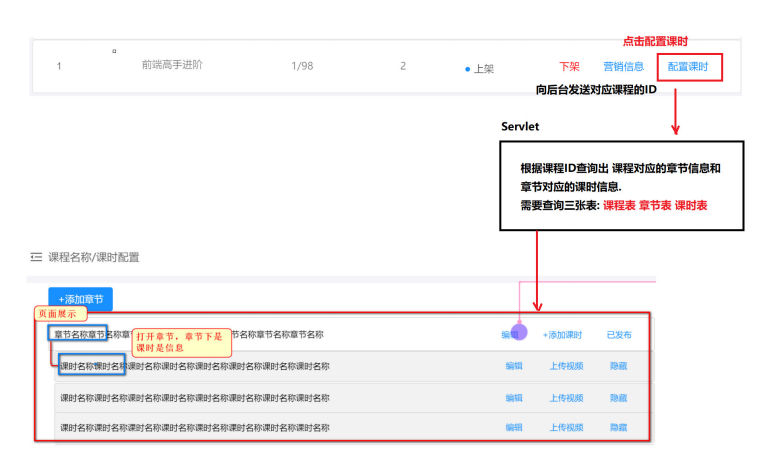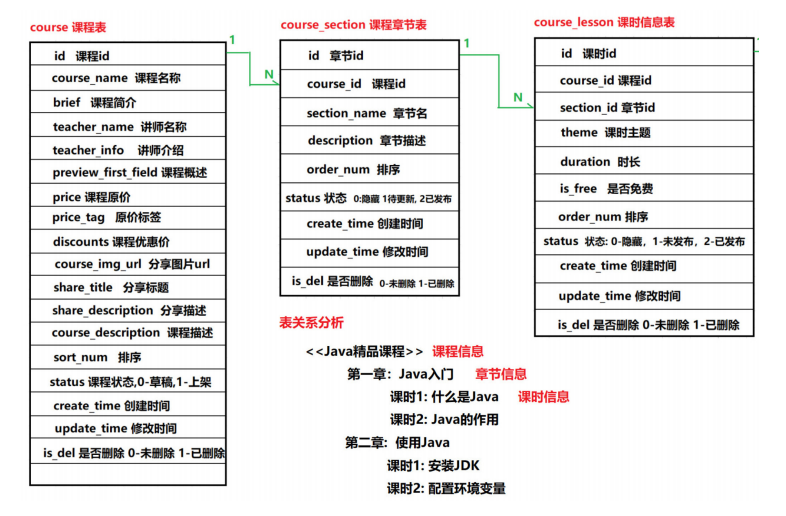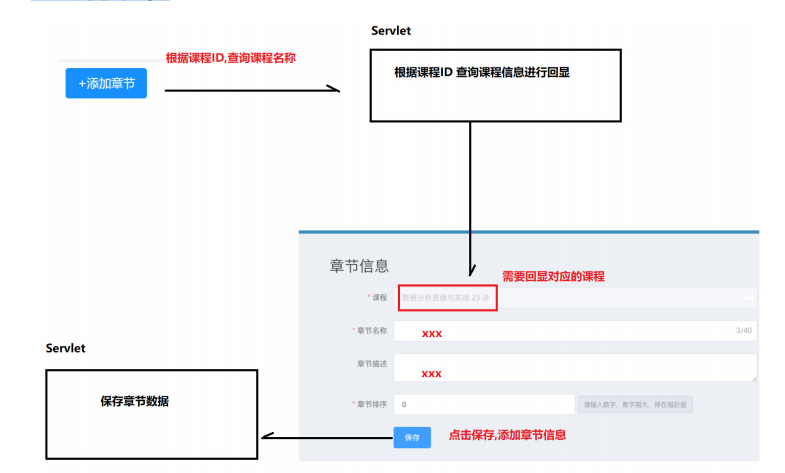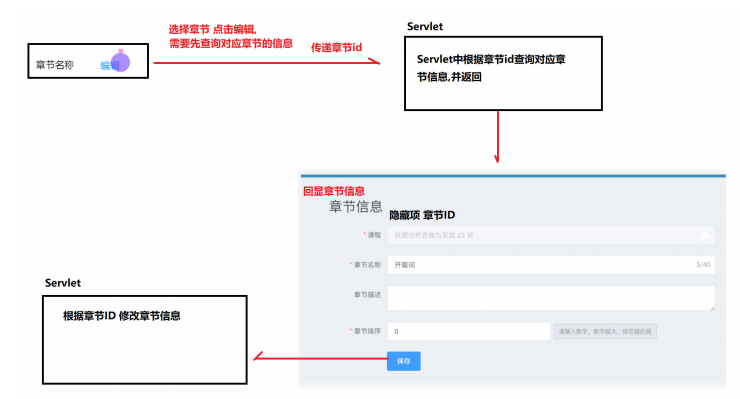java求职学习day43
任务三 课程管理模块开发_02
1.开发流程
1.1 需求分析
我们接下来开
发的是,配置课时(课程内容管理)模块,主要是对课程内容进行管理
发的是,配置课时(课程内容管理)模块,主要是对课程内容进行管理

1.2 数据库表分析

1.3 实体类设计
1) Course 类 与 Course_Section 类 是一对多关系
在 Course 类中定义一个List集合,并指定List的泛型是 Course_Section 类型,表示 一个课程中可以包
含多个章节
Course类
//添加list集合 泛型是 Course_Section
List<Course_Section> sectionList = new ArrayList<>();在 Course_Section 类中,定义一个Course类型的属性, 用来保存章节所对应的具体的课程信息
Course_Section 类
//添加一个Course类型的属性
private Course course;2) Course_Section 类 与 Course_Lesson 类是一对多关系
在Course_Section类中定义一个List集合,并指定List的泛型是 Course_Lesson类型,这样就可以表示
一个章节中包含多个课时.
Course_Section类
//添加一个list集合 泛型是 Course_lesson
List<Course_Lesson> lessonList = new ArrayList<>();
Course_Lesson类
//添加一个Course_Section类型的属性
private Course_Section course_section;1.4 Dao接口及实现类编写
/**
* 课程内容管理 DAO层接口
* */
public interface CourseContentDao {
}
/**
* 课程内容管理 DAO层实现类
* */
public class CourseContentDaoImpl implements CourseContentDao {
}1.5 Service接口及实现类编写
/**
* 课程内容管理 Service层接口
* */
public interface CourseContentService {
}
/**
* 课程内容管理 Service层实现类
* */
public class CourseContentServiceImpl implements CourseContentService {
}1.6 CourseContentServlet 编写
CourseContentServlet 继承 BaseServlet
@WebServlet("/courseContent")
public class CourseContentServlet extends BaseServlet {
}2. 功能一: 展示课程内容
2.1 需求分析
分析: 要展示的内容是对应课程下的 章节与课时信息

1) 我们先写一条查询语句: 查询ID为1 的课程的章节与课时信息
SELECT
cs.id '章节id',
cs.section_name '章节名称',
cl.id '课时id',
cl.theme '课时描述'
FROM course_section cs INNER JOIN course_lesson cl
ON cs.id = cl.section_id WHERE cs.course_id = ?2) 我们在程序中尽量避免使用连接查询,我们可以将上面的SQL进行拆分,每一条SQL对应一个功能
-- 根据课程ID查询章节相关的内容
SELECT
id,
course_id,
section_name,
description,
order_num
FROM course_section cs WHERE course_id = ? ;
-- 根据章节ID查询课时相关的内容
SELECT
id,
course_id,
section_id,
theme,
duration,
is_free,
order_nu
FROM course_lesson WHERE section_id = ?;2.2 DAO层编写
编写两个方法:
接口
//根据课程ID查询课程相关信息
public List<Course_Section> findSectionAndLessonByCourseId(int courseId);
//根据章节ID 查询章节相关的课时信息
public List<Course_Lesson> findLessonBySectionId(int sectionId);
实现类
//根据课程ID查询课程相关信息
@Override
public List<Course_Section> findSectionAndLessonByCourseId(int courseId) {
try {
//1.创建QueryRunner
QueryRunner qr = new QueryRunner(DruidUtils.getDataSource());
//2.编写SQL
String sql = "SELECT \n" +
"id,\n" +
"course_id,\n" +
"section_name,\n" +
"description,\n" +
"order_num,\n" +
"STATUS\n" +
"FROM course_section WHERE course_id = ?";
//3.执行查询
List<Course_Section> sectionList = qr.query(sql, new
BeanListHandler<Course_Section>(Course_Section.class), courseId);
//4.根据章节ID查询课时信息
for (Course_Section section : sectionList) {
//调用方法 获取章节对应的课时
List<Course_Lesson> lessonList =
findLessonBySectionId(section.getId());
//将课时数据封装到 章节对象中
section.setLessonList(lessonList);
}
return sectionList;
} catch (SQLException e) {
e.printStackTrace();
return null;
}
}
//根据章节ID查询课时信息
@Override
public List<Course_Lesson> findLessonBySectionId(int sectionId) {
try {
QueryRunner qr = new QueryRunner(DruidUtils.getDataSource());
String sql = "SELECT \n" +
"id,\n" +
"course_id,\n" +
"section_id,\n" +
"theme,\n" +
"duration,\n" +
"is_free,\n" +
"order_num,\n" +
"STATUS\n" +
"FROM course_lesson WHERE section_id = ?";
List<Course_Lesson> lessonList = qr.query(sql, new
BeanListHandler<Course_Lesson>(Course_Lesson.class), sectionId);
return lessonList;
} catch (SQLException e) {
e.printStackTrace();
return null;
}
}
public class TestCourseContentDao {
CourseContentDao contentDao = new CourseContentDaoImpl();
//测试 查询对应课程下的章节与课时
@Test
public void testFindSectionAndLessonByCourseId(){
List<Course_Section> list =
contentDao.findSectionAndLessonByCourseId(59);
for (Course_Section courseSection : list) {
System.out.println(courseSection.getId()+" =
"+courseSection.getSection_name());
List<Course_Lesson> lessonList = courseSection.getLessonList();
for (Course_Lesson lesson : lessonList) {
System.out.println(lesson.getId()+" = "+lesson.getTheme()+" = "
+ lesson.getSection_id());
}
}
}
}2.3 Service层编写
接口
/**
* 课程内容管理 Service层接口
* */
public interface CourseContentService {
//根据课程id查询课程内容
public List<Course_Section> findSectionAndLessonByCourseId(int courseId);
}
实现类
/**
* 课程内容管理 Service层实现类
* */
public class CourseContentServiceImpl implements CourseContentService {
CourseContentDao contentDao = new CourseContentDaoImpl();
@Override
public List<Course_Section> findSectionAndLessonByCourseId(int courseId) {
List<Course_Section> sections =
contentDao.findSectionAndLessonByCourseId(courseId);
return sections;
}
}2.4 Servlet编写
CourseContentServlet中添加 findSectionAndLessonByCourseId 方法
@WebServlet("/courseContent")
public class CourseContentServlet extends BaseServlet {
/**
* 展示对应课程的章节与课时信息
* */
public void findSectionAndLessonByCourseId(HttpServletRequest request ,
HttpServletResponse response){
try {
//1.获取参数
String course_id = request.getParameter("course_id");
//2.业务处理
CourseContentService contentService = new
CourseContentServiceImpl();
List<Course_Section> sectionList =
contentService.findSectionAndLessonByCourseId(Integer.parseInt(course_id));
//3.返回结果
String result = JSON.toJSONString(sectionList);
response.getWriter().println(result);
} catch (IOException e) {
e.printStackTrace();
}
}
}2.5 接口测试
查看接口文档,进行测试
3.功能二: 新建章节信息
3.1 需求分析

3.2 DAO层编写
接口
//添加章节时进行数据回显
public Course findCourseByCourseId(int courseId);
//保存章节信息
public int saveSection(Course_Section section);
实现类
/**
* 添加章节时进行数据回显
* */
@Override
public Course findCourseByCourseId(int courseId) {
try {
//1.创建QueryRunner
QueryRunner qr = new QueryRunner(DruidUtils.getDataSource());
//2.编写SQL
String sql = "SELECT id,course_name FROM course WHERE id = ?";
//3.执行查询
Course course = qr.query(sql, new BeanHandler<Course>(Course.class),
courseId);
//4.返回结果
return course;
} catch (SQLException e) {
e.printStackTrace();
return null;
}
}
@Override
public int saveSection(Course_Section section) {
try {
//1.创建QueryRunner
QueryRunner qr = new QueryRunner(DruidUtils.getDataSource());
//2.编写SQL
String sql = "INSERT INTO
course_section(course_id,section_name,description,order_num,STATUS,create_time,u
pdate_time)\n" +
"VALUES(?,?,?,?,?,?,?);";
//3.准备参数
Object[] param =
{section.getCourse_id(),section.getSection_name(),section.getDescription(),
section.getOrder_num(),section.getStatus(),section.getCreate_time(),section.get
Update_time()};
//4.执行插入
int i = qr.update(sql, section.getCourse_id(), param);
//4.返回结果
return i;
} catch (SQLException e) {
e.printStackTrace();
return 0;
}
}3.3 Service层编写
接口
public Course findCourseById(int courseId);
public String saveSection(Course_Section section);
实现类
@Override
public Course findCourseById(int courseId) {
Course course = contentDao.findCourseById(courseId);
return course;
}
@Override
public String saveSection(Course_Section section) {
//1.补全章节信息
section.setStatus(2); //状态,0:隐藏;1:待更新;2:已发布
String date = DateUtils.getDateFormart();
section.setCreate_time(date);
section.setUpdate_time(date);
//2.调用Dao进行插入
int i = contentDao.saveSection(section);
//3.根据插入是否成功,封装对应信息
if(i > 0){
//保存成功
String result = StatusCode.SUCCESS.toString();
return result;
}else{
//保存失败
String result = StatusCode.FAIL.toString();
return result;
}
}3.4 Servlet编写
CourseContentServlet中添加 findCourseById 方法
3.4.1 课程信息回显接口
//回显章节对应的课程信息
public void findCourseById(HttpServletRequest request , HttpServletResponse
response){
try {
//1.获取参数
String courseId = request.getParameter("course_id");
//2.业务处理
CourseContentService contentService = new
CourseContentServiceImpl();
Course course =
contentService.findCourseById(Integer.parseInt(courseId));
//3.返回数据,将对象转换为JSON,只转换需要的字段
SimplePropertyPreFilter filter = new
SimplePropertyPreFilter(Course.class,"id","course_name");
String result = JSON.toJSONString(course,filter);
response.getWriter().println(result);
} catch (Exception e) {
e.printStackTrace();
}
}3.4.2 保存章节信息接口
1. POST请求方式介绍
POST 请求方法常用的三种数据提交格式

注意: 第二种JSON格式与第三种多部件上传,使用 getParameter() 方法都无法获取数据
2. 需求分析分析
根据接口文档描述: 前台传输的是JSON格式的数据, 使用getParameter() 方法无法获取参数
{
"methodName":"saveOrUpdateSection",
"course_id":19,
"section_name:"微服务架构",
"description":"跟着药水一起学习如何使用微服务",
"order_num ":0
}3. 修改BaseServlet
如果请求参数是JSON格式的数, 我们可以通过 request.getReader() 这个方法,获取一个流对象来进行
读取.
1) 在BaseServlet 中创建一个方法,用来获取JSON格式的数据
/**
* POST请求格式为 application/json;charset=utf-8
* 在这个方法中我们使用流的方式,获取到POST请求的数据
* */
public String getPostJSON(HttpServletRequest request){
try {
//1.从request中获取 字符缓冲输入流对象
BufferedReader reader = request.getReader();
//2.创建 StringBuffer,用来保存读取出的数据
StringBuffer sb = new StringBuffer();
//3.循环读取
String line = null;
while((line = reader.readLine()) != null){
//追加到 StringBuffer中
sb.append(line);
}
//4.将读取到的内容转换为字符串,并返回
return sb.toString();
} catch (IOException e) {
e.printStackTrace();
return null;
}
}2) 修改BaseServlet中的doGet方法
1.获取POST请求的 Content-Type类型
2.判断传递的数据是不是JSON格式
3.如果是 就调用上面编写的 getPostJSON方法,获取数据
4.将获取到的JSON格式的字符串转换为 Map
5.从Map中获取要调用的方法名
6.将Map保存到request域对象中 (流只能使用一次)
@Override
protected void doGet(HttpServletRequest req, HttpServletResponse resp)
throws ServletException, IOException {
//1.获取参数 要访问的方法名
//String methodName = req.getParameter("methodName");
String methodName = null;
//2.获取POST请求的 Content-Type类型
String contentType = req.getHeader("Content-Type");
//3.判断传递的数据是不是JSON格式
if("application/json;charset=utf-8".equals(contentType)){
//是JOSN格式 调用getPostJSON
String postJSON = getPostJSON(req);
//将JSON格式的字符串转化为map
Map<String,Object> map = JSON.parseObject(postJSON, Map.class);
//从map集合中获取 methodName
methodName =(String) map.get("methodName");
//将获取到的数据,保存到request域对象中
req.setAttribute("map",map);
}else{
methodName = req.getParameter("methodName");
}
//2.判断 执行对应的方法
if(methodName != null){
//通过反射优化代码 提升代码的可维护性
try {
//1.获取字节码文件对象
Class c = this.getClass();
//2.根据传入的方法名,获取对应的方法对象 findByName
Method method = c.getMethod(methodName,
HttpServletRequest.class, HttpServletResponse.class);
//3.调用method对象的 invoke方法,执行对应的功能
method.invoke(this,req,resp);
} catch (Exception e) {
e.printStackTrace();
System.out.println("请求的功能不存在!!");
}
}
}4. 编写接口代码
/**
* 保存&修改 章节信息
* */
public void saveOrUpdateSection(HttpServletRequest request
,HttpServletResponse response){
try {
//1.获取参数 从域对象中获取
Map<String,Object> map = (Map)request.getAttribute("map");
//2.创建Course_Section
Course_Section section = new Course_Section();
//3.使用BeanUtils工具类,将map中的数据封装到 section
BeanUtils.populate(section,map);
//4.业务处理
CourseContentService contentService = new
CourseContentServiceImpl();
String result = contentService.saveSection(section);
//5.响应结果
response.getWriter().print(result);
} catch (Exception e) {
e.printStackTrace();
}
}5. 测试接口
1) 选择POST请求方式,设置Content-Type = application/json

2) 选择raw 发送JSON格式数据

4.功能三: 章节信息修改
需求分析:

注意: 接口文档中并没有要求编写回显接口,说明回显操作由前端完成.
4.1 DAO层编写
接口
//修改章节信息
public int updateSection(Course_Section section);
接口实现类
/**
* 修改章节信息
* */
@Override
public int updateSection(Course_Section section) {
try {
//1.创建QueryRunner
QueryRunner qr = new QueryRunner(DruidUtils.getDataSource());
//2.编写SQL
String sql = "UPDATE course_section SET\n" +
"section_name = ?,\n" +
"description = ?,\n" +
"order_num = ?,\n" +
"update_time = ? WHERE id = ?;";
//3.准备参数
Object[] param =
{section.getSection_name(),section.getDescription(),section.getOrder_num(),
section.getUpdate_time(),section.getId()};
//4.执行修改操作
int row = qr.update(sql, param);
return row;
} catch (SQLException e) {
e.printStackTrace();
return 0;
}
}4.2 Service层编写
接口
public String updateSection(Course_Section section);
实现类
@Override
public String updateSection(Course_Section section) {
//1.补全章节信息
String date = DateUtils.getDateFormart();
section.setUpdate_time(date);
//2.调用Dao进行插入
int i = contentDao.updateSection(section);
//3.根据修改是否成功,封装对应信息
if(i > 0){
//保存成功
String result = StatusCode.SUCCESS.toString();
return result;
}else{
//保存失败
String result = StatusCode.FAIL.toString();
return result;
}
}4.3 Servlet编写
保存章节信息和修改章节信息,访问的是同一个接口,所以在saveOrUpdateSection方法中中,我们要进
行一下判断
携带id 就是修改章节操作
未携带id就是新增章节操作
/**
* 保存或修改章节信息
* */
public void saveOrUpdateSection(HttpServletRequest request ,
HttpServletResponse response){
try {
//1.获取参数
Map<String, Object> map =(Map) request.getAttribute("map");
//2.创建 Course_Section
Course_Section section = new Course_Section();
//3.使用BeanUtils,将map中的数据封装到section对象里
BeanUtils.copyProperties(section,map.get("section"));
//4.业务处理
CourseContentService contentService = new
CourseContentServiceImpl();
if(section.getId() != 0){
//修改操作
String result = contentService.updateSection(section);
//5.返回结果数据
response.getWriter().println(result);
}else{
//添加操作
String result = contentService.saveSection(section);
//5.返回结果数据
response.getWriter().println(result);
}
} catch (Exception e) {
e.printStackTrace();
}
}4.4 接口测试
查看接口文档,进行测试
5.功能四: 章节状态管理
6.1 需求分析
根据选择的状态信息,发送对应的状态编号 进行修改, status 状态,0:隐藏;1:待更新;2:已发布

6.2 DAO层编写
接口
//修改章节的状态
public int updateSectionStatus(int id,int status);
实现类
/**
* 修改章节状态
* */
@Override
public int updateSectionStatus(int id,int status) {
try {
//1.创建QueryRunner
QueryRunner qr = new QueryRunner(DruidUtils.getDataSource());
//2.编写SQL
String sql = "UPDATE course_section SET STATUS = ?,update_time = ?
WHERE id = ?;";
//3.准备参数
Object[] param = {status , DateUtils.getDateFormart(),id};
//4.执行修改操作
int row = qr.update(sql, param);
return row;
} catch (SQLException e) {
e.printStackTrace();
return 0;
}
}6.3 Service层编写
接口
public String updateSectionStatus(int id,int status);
实现类
@Override
public String updateSectionStatus(int id, int status) {
//调用Dao 修改状态
int i = contentDao.updateSectionStatus(id,status);
//3.根据修改是否成功,封装对应信息
if(i > 0){
String result = StatusCode.SUCCESS.toString();
return result;
}else{
String result = StatusCode.FAIL.toString();
return result;
}
}6.4 Servlet编写
/**
* 修改章节状态
* */
public void updateSectionStatus(HttpServletRequest request ,
HttpServletResponse response){
try {
//1.获取参数
int id = Integer.parseInt(request.getParameter("id"));
int status = Integer.parseInt(request.getParameter("status"));
//4.业务处理
CourseContentService contentService = new
CourseContentServiceImpl();
String result = contentService.updateStatus(id, status);
//5.返回结果数据findSectionById
response.getWriter().println(result);
} catch (Exception e) {
e.printStackTrace();
}
}6.5 接口测试
按照接口文档进行测试
